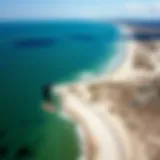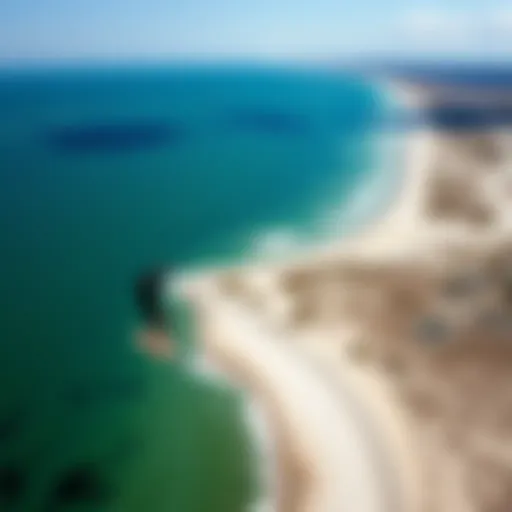Exploring the San Francisco Wind Map for Kiteboarding
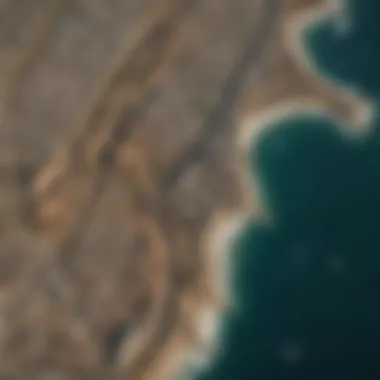

Intro
Kiteboarding is a sport that thrives on the unpredictable dance of the wind. For those riding the waves in San Francisco, understanding local wind patterns isn't just a bonus—it’s essential. The San Francisco Wind Map serves as a vital tool for kiteboarders, whether you're just starting out or have been slicing through the surf for years. By examining this unique topographical representation, enthusiasts can make informed decisions about when and where to kite, maximizing their enjoyment and safety.
As we dive deeper into this topic, we’ll scrutinize the intricate dynamics of wind currents, explore seasonal variations that can impact kiteboarding conditions, and dissect the influence of geography on wind patterns. Each section will build a connection between the wind conditions depicted on the map and practical kiteboarding applications.
Equipment Insights
Having the right gear can make or break your kiteboarding experience. Analyzing the San Francisco Wind Map not only heightens your situational awareness but also underlines the importance of selecting appropriate equipment tailored to local conditions.
Latest Gear Reviews
Kiteboarding equipment is evolving at a rapid pace, with brands constantly innovating to enhance performance and safety. A few popular brands, like Cabrinha and Duotone, have unveiled models that cater to different wind strengths commonly found in San Francisco. For instance, the Cabrinha Switchblade is renowned for its versatility, making it an excellent choice for breezy days on the bay. Alternatively, if you’re looking for a lightwind option, the Duotone Evo might just do the trick.
When examining gear, it’s crucial to focus on:
- Kite Size: In light wind, a larger kite is essential. Conversely, during strong gusts, you’ll want something smaller and more manageable.
- Bar Length and Lines: Opt for lines that offer an efficient response during varying wind conditions. Look for bars with adjustable lengths, allowing quick adjustments as conditions change.
- Harness Comfort: You’ll spend hours on the water, so a comfortable harness that doesn’t dig in is key.
Essential Gear Maintenance
Taking care of your equipment can prolong its lifespan and performance. Here are some vital maintenance tips:
- Regular Cleaning: Keep your kites free from saltwater and sand, which can cause wear over time.
- Inspect for Damage: Check your lines and seams for signs of wear. A frayed line could lead to catastrophic failure.
- Storage Practices: After a day on the water, ensure your gear is dried properly before storing to avoid mildew and deterioration.
Technique Exploration
Practical knowledge of wind patterns is one side of the equation; skill level makes up the other. Whether you’re a novice or a seasoned veteran, mastering kiteboarding techniques is paramount for both enjoyment and safety.
Beginner Techniques
For those just stepping onto the board, it’s essential to understand how to handle your kite in various wind conditions. You should focus on:
- Body Dragging: This vital skill helps you understand how wind affects the kite. Practice body dragging across the water to develop a feel for the wind.
- Water Start: Mastering this will allow you to transition smoothly from the water to the board, optimizing your session every time.
Advanced Maneuvers
As skills develop, kiteboarders may seek to push their boundaries. Those advanced riders tackling the San Francisco waves might enjoy:
- Jumping and Tricks: Understanding wind direction helps in executing jumps effectively. Tweak your pop based on the wind's intensity to maximize height.
- Transitions: Use the wind to your advantage for quick direction changes without losing speed.
By understanding the San Francisco Wind Map and having the right equipment along with refined techniques, riders can harness the power of the elements. The thrill of kiteboarding is enhanced when you can predict and adapt to the ever-changing wind patterns of the bay.
Understanding Wind Dynamics
Understanding wind dynamics is crucial for kiteboarders. The way wind behaves can make or break a session on the water. Anyone who has strapped on a kite has likely realized that the fun often hinges on wind conditions. It’s not just about having a breeze; it’s about knowing the subtle nuances that come with it. By paying attention to wind dynamics, riders can ensure safer, more enjoyable outings.
The importance of studying the patterns and behaviors of wind cannot be overstated. First, it helps to identify what kind of wind is favorable for kiteboarding. Each kiteboard setup requires specific wind conditions to perform optimally. Knowing how the wind interacts with local geography can lead to a more elevated riding experience.
There are key benefits to delving deeper into wind dynamics:
- Safety: Knowledge helps avoid dangerous situations like sudden gusts or lulls.
- Performance: Understanding wind types leads to better control over the kite, thereby improving performance.
- Planning: Kiteboarders can better plan outings based on forecasted wind patterns.
Furthermore, a sound grasp of wind dynamics provides kiteboarders with insights into their local environment. Is there an area with consistent winds? Do certain times of the year have winds that are better suited for riding? These questions shape the experience and can lead to finding hidden gems in often overlooked locations.
The Science Behind Wind Patterns
Wind patterns are influenced by several factors, including temperature, pressure, and the topography of the area. In essence, it boils down to physics. Hot air rises, cool air sinks. This movement creates wind as air masses shift to fill the gaps left by rising warm air. It's this shifting that kiteboarders must learn to read.
San Francisco's unique geography plays a significant role in its wind dynamics. With the Pacific Ocean on one side and the Sierra Nevada mountains on the other, this bay area experiences fascinating phenomena. For example, the wind tends to funnel through the Golden Gate, creating stronger gusts ideal for kiteboarding. Local riders often both look for and take advantage of these shifting air patterns.
"Wind is like a ribbon that dances; it flows and twists, leading you wherever it pleases—understanding it is key to mastering the ride."
Seasonal Wind Variations
Kiteboarders must also keep an eye on seasonal wind variations. Different times of the year bring about changes in temperature and pressure that can dramatically alter wind experiences. During the summer, the coast generally experiences stronger and more consistent winds compared to winter months.
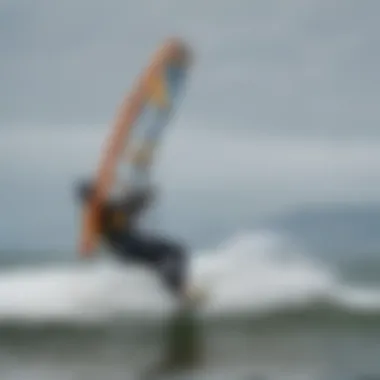

- Summer months often bring steady sea breezes. As the land heats up, cooler air from the ocean rushes in. It’s during these times that many kiteboarders head out to reliable spots like Crissy Field and Alameda.
- Winter months, in contrast, can offer lighter winds and more unpredictable conditions. This doesn’t mean kiteboarding is off the table; instead, riders must be adaptable, able to navigate the trickier, shifting winds that can accompany the cooler months.
Riders who pay attention to these seasonal changes can adjust their gear and choose the right locations accordingly, ensuring they remain at the forefront of kiteboarding performance.
The San Francisco Wind Map Overview
Understanding the San Francisco Wind Map holds significant weight for those involved in kiteboarding. The map doesn’t merely represent wind patterns; it serves as a lifeline for kiteboarders seeking optimal conditions. Knowledge of this map can mean the difference between an exhilarating day on the water or a frustrating struggle against the breeze. The San Francisco Bay Area is known for its unpredictable wind, which can shift dramatically in just a matter of minutes. That’s why a detailed appreciation of this wind mapping tool can be a game-changer for enthusiasts of all skill levels.
Map Features and Design
The San Francisco Wind Map features a striking design that lays out comprehensive wind data across the region. With gradient colors indicating wind strengths, the map allows users to quickly assess conditions at a glance. Intuitive legends describe the wind speed, direction, and even gust potential. This user-friendly interface invites beginners to engage while providing advanced kiteboarders with the data they crave. Notably, one can find overlays of geographic landmarks, which can help locate ideal spots based on the wind dynamics.
One clever aspect of the map is its layering capability. Users can switch between historical wind data and real-time forecasts, allowing for a multi-dimensional view of conditions. Additionally, some versions include tide information, which can affect overall kiteboarding experiences. It’s almost like having a personal assistant who knows the ins and outs of every area.
Aside from aesthetic appeal, the map’s design ensures that kiteboarders can make informed decisions before taking to the water. By understanding wind direction, which can create both cleaner and more chaotic conditions, a rider can prepare mentally and physically. Thus, comprehending the wind map translates to better safety and more thrilling kiteboarding.
Data Sources and Accuracy
The accuracy of any wind map is central to its relevance, and the San Francisco Wind Map relies on multiple data sources to ensure reliability. Meteorological data is collected from various stations around the Bay Area, which makes the information robust. Professional weather stations, buoys, and satellite imagery contribute to understanding the wind's behavior.
Most importantly, it’s essential to recognize that real-life conditions can diverge from what the map displays. Just because a spot shows green, indicating mild wind, doesn't guarantee calm conditions when you arrive. Microclimates play a significant role here. Areas like Treasure Island or Crissy Field might display very different wind patterns from neighboring locations. Therefore, comprehending how local factors influence the map's readings is vital.
Above all, the map reflects trends rather than certainties. Therefore, kiteboarders should be cautious and flexible. Being prepared for fluctuations can turn an anticipated outing into an enjoyable adventure instead of a disapointing affair.
Regional Influence on Wind Patterns
Understanding the regional influence on wind patterns is pivotal for kiteboarding enthusiasts. San Francisco’s geography and climate create a unique interplay that directly affects the wind characteristics across various locations. This thorough examination of regional wind dynamics dives deep into specific elements, benefits, and considerations essential for kiteboarders.
Geography of the San Francisco Area
San Francisco is nestled on the northern tip of the San Francisco Peninsula, bordered by the Pacific Ocean to the west and the San Francisco Bay to the east. The city's topography is marked by hills and valleys, which can create pockets of varying wind strengths and directions. Notably, the presence of Golden Gate Park and the eastern shores of the bay influence local wind patterns, serving as barriers and catalysts for airflow.
The coastal regions experience consistent breezes influenced by ocean currents and temperature gradients between land and water. During warmer months, the inland areas heat up, creating a low-pressure zone that draws in cooler air from the ocean, leading to frequent and reliable winds. In turn, this phenomenon is extremely beneficial for kiteboarders who thrive on steady conditions. However, the hills and valleys around the city can also create turbulence, resulting in localized wind shifts.
This geographical complexity means that kiteboarders need to be astute, keenly aware of how different spots around the bay respond to varying weather patterns. Some areas, like Crissy Field, are well-known for their consistent winds, while others may present unpredictable gusts or lulls. Thus, understanding the nuances of the landscape is integral to planning improved kiteboarding outings.
Microclimates and Their Impact
Microclimates in the San Francisco area play a significant role in shaping the local wind dynamics that affect kiteboarding conditions. The term
Applications for Kiteboarding
Understanding the wind and its behavior is pivotal for kiteboarding, particularly in a diverse landscape like San Francisco. Kiteboarding is not just about having a board and a kite; it's about harnessing the strengths of the wind to glide over water in a smooth and controlled manner. Knowing when, where, and how to ride the winds elevates the experience and can significantly enhance performance. This section will explore how kiteboarders can make the most of the wind map to their advantage, the optimal conditions to seek, and the spots best suited for this exhilarating sport.
Optimal Wind Conditions for Kiteboarders
Wind condition can be the make-or-break factor for a successful kiteboarding session. Ideally, kiteboarders should aim for consistent, steady winds ranging from 12 to 25 mph. These winds allow riders to easily control their kites while maintaining speed across the water. Below are some essential factors to consider when evaluating wind conditions:
- Wind Speed: Levels below 12 mph can be insufficient for most kites, while wind speeds above 25 mph may be too strong for beginners.
- Wind Direction: The ideal wind direction largely depends on the location. Offshore winds tend to blow away from the shore, making them more suitable for experienced riders. Onshore winds, coming from the sea towards the land, are typically safer for most kiteboarders.
- Wind Consistency: Look for areas with consistent wind patterns, which will help you avoid unpredictable gusts that can twist your kite and cause difficulties mid-ride.
"Investing time in understanding wind conditions is like having a cheat sheet before an important exam; it sets you up for success."
Identifying Ideal Locations
Location is key in kiteboarding, especially given the ever-changing whims of the wind. San Francisco offers a variety of spots that cater to different skill levels and preferences. Here are a few notable places to scout out:
- Crissy Field: Known for its reliable winds, this is an ideal location for both novice and experienced kiteboarders. The wind typically picks up in the late afternoon, providing the perfect setting for a solid kiteboarding session.
- Ocean Beach: Offers powerful waves along with strong winds, ideal for advanced kiteboarders looking for a challenge. However, caution should be exercised due to rip currents in the area.
- Fort Point: This spot is favored for flat water conditions and tends to be less crowded. Plus, it presents a unique view of the Golden Gate Bridge, making it a picturesque location to ride.
- Alameda: This area is perfect for beginners, as it features shallow waters and consistent winds. It’s an excellent place for learning and honing skills without extreme conditions.
By understanding the wind dynamics and exploring various locations, kiteboarders can find the perfect balance between thrill and safety. Integrating the San Francisco Wind Map into practice enables enthusiasts to gear up for their best sessions, turning the unpredictable into a predictable source of enjoyment.
Maximizing Kiteboarding Experience
Kiteboarding, while thrilling, hinges significantly on the ability to adapt to the ever-changing wind conditions. Understanding how to read the wind map effectively and respond to those shifts is essential for ensuring both a fun and safe experience on the water. This section is dedicated to exploring these vital components, providing actionable insights for kiteboarders that can enhance their outings.
Reading the Wind Map Effectively
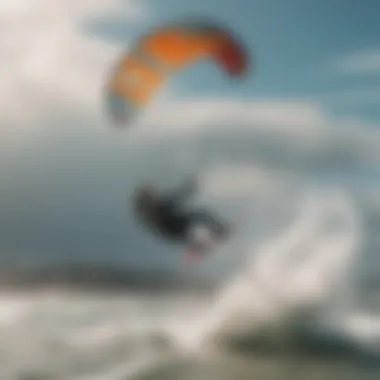

To make the most out of kiteboarding adventures, the first step is getting familiar with the San Francisco Wind Map. The map is not merely a visual representation; it's a tool that can help predict wind behavior, identify optimal spots, and enhance the overall kiteboarding experience.
Begin by taking note of the colors on the wind map. Each hue represents varying wind speeds. For instance, shades of blue might indicate lighter winds, while shades of red could signify stronger gusts. Understanding these color gradations can inform whether to use a larger or smaller kite.
Additionally, pay attention to the direction of the wind arrows. These arrows don’t just indicate the wind's path; they give you insight on potential turbulence or smooth sailing. When heading out, look for signs of consistent wind patterns on the map—more stability means a higher chance of a successful ride. Here are a few tips for reading the map:
- Identify wind speed thresholds: Know the wind speeds that suit your skill level for safety and performance.
- Look for anomalies: A sharp change in wind direction or speed may signal rough areas or possible hazards.
- Consult local knowledge: Engaging with local kiteboarders can provide context for the map’s readings, considering variations that may not be charted.
Adapting to Changing Conditions
Once you're on the water, the skies can turn quite quickly—what was fair weather a moment ago can morph into challenging gusts. Kiteboarders must be prepared to adjust their techniques and equipment based on the shifting winds.
Here are a few strategies to help you adapt:
- Stay agile: Keep your movements fluid to handle sudden wind changes. If the wind suddenly picks up, lean back into your harness and maintain a low center of gravity.
- Choose the right equipment: Selecting the appropriate kite size and adjusting board types can drastically affect your performance. A smaller kite can be beneficial when the winds are gusting heavily.
- Monitor the environment: Take note of the surrounding area. Trees, buildings, and hills can create wind shadows or gusts that significantly differ from open water.
Ultimately, kiteboarding is about predicting and reacting thoughtfully to nature’s whims. Equipped with the knowledge to read the wind map correctly and adapt to its changes, riders can significantly increase their chances of a successful day on the water. Embrace flexibility and stay attuned to your surroundings, and you’ll uncover new levels of enjoyment and challenge with each session.
By being well-prepared and informed, kiteboarding can transition from a mere hobby to an exhilarating pursuit that offers adventure with every ride.
Reading the wind map and adapting to changing conditions are skills that take time to develop. However, with patience and practice, every kiteboarder can hone these abilities.
Safety Considerations
Safety is paramount in any adventure sport, and kiteboarding in the San Francisco bay area is no exception. Understanding the unique challenges posed by local wind conditions can make all the difference. Kiteboarders should be aware that winds here can be erratic, shifting quickly and unexpectedly. This unpredictability can lead to hazardous situations if proper care isn’t taken. Therefore, knowledge and preparation become vital tools in ensuring a safe and enjoyable kiteboarding experience.
Understanding Wind Hazards
When kiteboarding, it's crucial to recognize the potential hazards that winds can present. The San Francisco area, with its varied topography, creates localized wind events that might not be apparent until you’re on the water.
- Gusts: Sudden spikes in wind speed can catch even seasoned riders off guard. These gusts can come out of nowhere, changing the dynamics of your ride significantly. It’s essential to keep an eye on the flags and trees, as their movement can signal these unexpected changes.
- Directional Shifts: The winds can swirl and switch direction abruptly, especially near the Golden Gate Bridge. This can put kiteboarders in difficult positions if they are not prepared to adjust quickly.
- Thermal Winds: The unique microclimates of the Bay Area mean you need to be aware of rising thermal winds. These winds can create turbulent conditions that are not only uncomfortable but potentially dangerous.
- Crosswinds: Kiteboarding in crosswinds can lead to challenging situations, limiting control over your kite. This can increase the likelihood of stalling or even crashing into the water. Trust the wind map to guide you to the best spots for your skill level.
"Knowledge is your best safety net. Understanding the wind is just as important as having the right gear."
Emergency Preparedness
Being prepared for emergencies can be a lifesaver. While a thrilling ride is the goal, the ocean’s temperament can change, and kiteboarders need to know how to react swiftly and effectively.
- Gear Check: Before hitting the water, ensure all safety gear is functioning correctly. That means checking your harness, lines, and kite for wear and tear. A small issue can escalate into a big problem if not addressed.
- Communication: Having a reliable method of communication is essential. Whether it’s between mates on the shore or using a device like a whistle, keeping in touch can help in emergencies.
- Emergency Protocols: Familiarize yourself with the local emergency response procedures. Knowing who to contact and how to signal for help in a crisis can make a big difference.
- Practice Scenarios: Training for emergency situations regularly can help you remain calm when the unexpected happens. Run through drills with friends so that everyone knows what steps to take.
- Know Your Limits: Perhaps the most vital point is understanding your own capabilities. Know when to call it a day. If conditions change, recognize that it’s ok to pack up and leave the water.
By being vigilant and prepared, kiteboarders can enjoy everything that the San Francisco winds offer while minimizing risks.
Case Studies: Wind Conditions in Practice
In this segment, we’ll navigate through real-life examples that illustrate the myriad ways wind conditions can shape kiteboarding experiences in San Francisco. Case studies provide kiteboarders with practical insights, helping them not only to enjoy successful or challenging outings but also to draw lessons from each situation. These anecdotes can foster a better understanding of how to approach different wind scenarios, an essential aspect for all kiteboarders, from novices to seasoned pros.
Successful Kiteboarding Days
Successful kiteboarding days often hinge on understanding the wind map and the conditions of the day. For instance, one northern California kiteboarder, Josh, recalls an exhilarating day at Ocean Beach. It was mid-summer, and the wind forecast showed a steady pattern reaching up to 25 knots by noon.
With his friends, Josh arrived early, eager to catch the best gusts. With the wind map indicating a favorable offshore breeze, they set up their gear and launched into the water. The experience was electric—smooth rides, effortless jumps, and ample opportunities for tricks. The combination of the wind speed and the weather patterns led to what could only be described as a kiteboarding paradise.
Key factors that contributed to their success included:
- Early arrival: Getting to the beach before peak times allowed them to select prime spots.
- Attention to wind changes: Being aware of sudden shifts in wind direction and intensity kept them on their toes.
- Familiarity with local spots: Knowing the intricacies of Ocean Beach’s conditions gave them an edge.
Josh’s story encapsulates a perfect day—that blend of preparation, communication, and the ability to trust in one’s knowledge of the wind map.
Lessons from Unfavorable Conditions
Conversely, unfavorable wind conditions offer critical lessons that no kiteboarder should overlook. Take Sarah’s experience at Crissy Field one winter afternoon. An enthusiastic rider, Sarah knew that winter winds could be tricky, but her excitement led her to hit the water despite a forecast warning low winds mixed with sudden gusts.
As she launched her kite, the wind dwindled to a mere whisper. This rapidly shifted, as unexpected gusts kicked in. A riptide began pulling her towards the buoys marking the sailing area, with sporadic changes in the wind challenging her control. Fortunately, Sarah had prepared with safety gear and remained calm, guiding her kite to a safe landing while maintaining her distance from more congested areas on the water.
From Sarah’s ordeal, other kiteboarders can glean important insights:
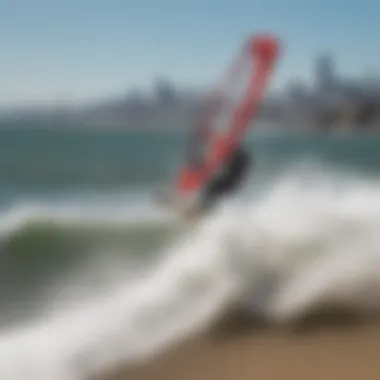

- Always check the wind map before heading out. Flighty conditions can come unexpectedly, and being prepared can save a lot of trouble.
- Listening to the weather reports and forecasts can be a game-changer. Conditions can shift dramatically, and it's vital to stay informed.
- Safety gear is essential. Wearing a harness and a buoyancy aid can provide an added layer of safety during unforeseen wind changes.
"The ocean doesn’t lie; it tells you what to expect, but you have to listen."
Through these lessons from unfavorable days, kiteboarders build resilience, learn to adapt, and ultimately become more savvy riders.
Community Insights and Experiences
The kiteboarding community in San Francisco is a vibrant tapestry woven from the diverse experiences of local riders. Understanding these insights is vital to both new and seasoned kiteboarders, as it presents a real-world perspective that complements theoretical knowledge. Community input can shed light on how wind conditions, geographical nuances, and personal anecdotes intersect to influence kiteboarding experiences. Riders sharing their first-hand encounters not only provide guidance but also build a sense of camaraderie and support among enthusiasts.
Local Rider Contributions
Riders contribute significantly to the collective knowledge about wind patterns and conditions on the San Francisco Wind Map. Many local kiteboarders take to social media platforms like Facebook and Reddit to share their daily experiences, discussing how wind behaves at various spots throughout the Bay Area. These contributions often include:
- Personal Narratives: Individual stories about successful sessions or unexpected changes can teach lessons that statistics alone cannot. It gives a human angle to the data.
- Spot Recommendations: By outlining their favorite locations, riders help others navigate the various microclimates and wind conditions that characterize the region.
- Tips for Troubleshooting: From discussing equipment adjustments to strategies for dealing with sudden wind shifts, local riders often know what works best based on trial and error.
For instance, a rider might share how they were caught off guard by an unexpected gust at Ocean Beach and highlight how they adapted their technique. This narrative doesn’t simply recount a day out; it educates the community on the importance of always keeping awareness of changing conditions.
Expert Opinions on Wind Management
Expert opinions carry weight in the world of kiteboarding. Engaging with professionals, such as experienced instructors or meteorologists, can provide crucial insights into effectively managing wind conditions on the water. These experts often emphasize the following:
- Understanding Wind Forecasts: A professional instructor may explain how to interpret local forecasts accurately, emphasizing the nuances that a kiteboarder should pay attention to, such as wind direction, intensity, and potential gusts.
- Practical Strategies: Experts offer practical, actionable tips that kiteboarders can apply, like adjusting their rigging or understanding when to stay off the water during adverse conditions. For example, a meteorologist might advise riders to avoid certain locations when the wind has a strong onshore component, illustrating how knowledge of local winds can translate to safer and more enjoyable sessions.
- Risk Mitigation: Many professionals underscore the importance of risk assessment when evaluating wind conditions. They guide riders to make informed decisions, thus enabling them to maximize enjoyment while minimizing hazards.
"Local knowledge can be your best asset. It's not just about knowing how to kite but understanding the invisible force that drives your success on the water." - Anonymous Instructor
In essence, marrying the experiences of local riders with expert insights creates a more comprehensive understanding of kiteboarding in San Francisco. This synergy not only aids in navigating the complexities of wind patterns but also enriches the overall kiteboarding culture in the area.
The Future of Wind Mapping
As the world continues to evolve with the times, the future of wind mapping holds immense potential, especially for kiteboarding in regions like San Francisco. The integration of advanced technologies into wind mapping allows for a level of detail and accuracy that was previously unimaginable. This synthesis of data and user experience promises to redefine how kiteboarders assess and approach their sport, making it not just safer but also more enjoyable.
Wind maps are not just charts; they are essential tools that offer a wealth of information. Kiteboarders can benefit immensely from accurate wind data, which translates into better planning and more successful outings. By leveraging advances in technology, kiteboarders can access real-time updates and forecasts, shaping their choices on the water. The implications of this are significant, as kiteboarders can optimize their gear and strategies based on precise conditions.
Advancements in Technology
In recent years, technology has surged forward in ways that enhance wind mapping capabilities. For instance, satellite imagery combines with on-the-ground sensors, generating detailed data that can track changes in wind patterns almost instantaneously. Moreover, mobile apps that reflect real-time conditions play a pivotal role in keeping kiteboarders informed.
Some notable advancements include:
- Remote Sensing: This tech captures wind direction and speed over vast areas, allowing for a more comprehensive view of conditions.
- Machine Learning Algorithms: These can analyze historical data to predict future conditions, giving riders the edge in anticipating changes.
- Crowdsourced Data: Platforms like Reddit enable local kiteboarders to share their insights on conditions, making it easier for newcomers to find the best spots and times.
These advancements mean that accessing reliable data is easier than ever before. Riders equipped with this information not only enhance their skill but also contribute to a safer riding environment, reducing mishaps caused by unexpected shifts in wind.
Integrating Data with Experience
However, mere access to data is not enough; integrating that data into practical kiteboarding experiences is where the real challenge lies. Understanding how to interpret wind maps effectively takes time and practice. The goal is to make real-time adjustments based on the data received.
Kiteboarders, especially those who are relatively new to the sport, should familiarize themselves with tools and applications that can help synthesize data. Here are some practical approaches to effectively merge data with experience:
- Training Sessions: Engaging in activities with seasoned kiteboarders allows newcomers to learn how they interpret wind maps.
- Experimentation: Regularly venturing out to different spots can help riders refine their understanding of how winds behave in various conditions.
- Dialogue with Local Experts: This can provide invaluable insights, helping riders combine empirical knowledge with up-to-date data.
Epilogue: The Value of Wind Knowledge
Understanding wind patterns and dynamics is essential for kiteboarders who want to make the most of their time on the water. The San Francisco Wind Map serves as a practical tool that can help riders tap into the forces of nature – ultimately enhancing their performance and safety.
Harnessing Wind for Optimal Performance
For kiteboarders, wind is not just a backdrop but the main act. Knowing how to read the wind can mean the difference between a day of thrilling rides and sitting on the shore. Many factors come into play here, from the average wind speeds to the gusty unpredictability of certain locations along the San Francisco coastline.
- Understanding Wind Directions: Kiteboarders need to grasp how wind direction affects their rides. Winds blowing offshore can present unique challenges but also facilitate remarkable adventures when mastered.
- Using Wind Maps Wisely: Wind maps are not just charts; they are guides to understanding real-time conditions. The trick is not to look solely at the wind speed but to listen to the gusts and shifts. This is where the experience of local riders can offer invaluable insights.
- Adjusting Gear Accordingly: Type of kite and board play an enormous role here. Riding with a smaller kite can be prudent when conditions are gusty, while larger kites can be advantageous when the wind is steady.
A kiteboarder should always be willing to adapt strategies as conditions change, much like a sailor who constantly adjusts their sails. Recognizing when to pull in or let out the line is also part of harnessing wind for peak performance.
"Wind knowledge isn’t just for weathermen; it’s vital for all kiteboarders aiming for that perfect day on the waves."
Encouraging Responsible Kiteboarding Practices
While the thrill of kiteboarding in favorable winds is enticing, it's equally important to emphasize responsible practices on the water. Every kiteboarder carries the responsibility of ensuring their activities don’t endanger themselves or others.
- Recognizing Hazardous Conditions: It’s critical to pay attention to both the weather forecast and on-site conditions. Sudden weather changes can create dangerous scenarios—whether it’s an unexpected wind shift or swings in temperature. Always check for stronger gusts before setting out.
- Following Local Regulations and Guidelines: Being aware of designated kiteboarding areas and respecting other water users helps maintain a harmonious environment. This means keeping a safe distance from swimmers, surfers, or other watercraft.
- Educating Less Experienced Riders: Fostering a sense of camaraderie is crucial. Encouraging new kiteboarders to remain informed about wind dynamics and safety practices will lead to a healthier kiteboarding community.
Ultimately, understanding and respecting the wind transcends just kiteboarding—it's about creating a culture of safety and enjoyment for everyone involved. Kiteboarding isn't merely a sport; it's an art that requires an appreciation of nature and a commitment to responsible practices.
